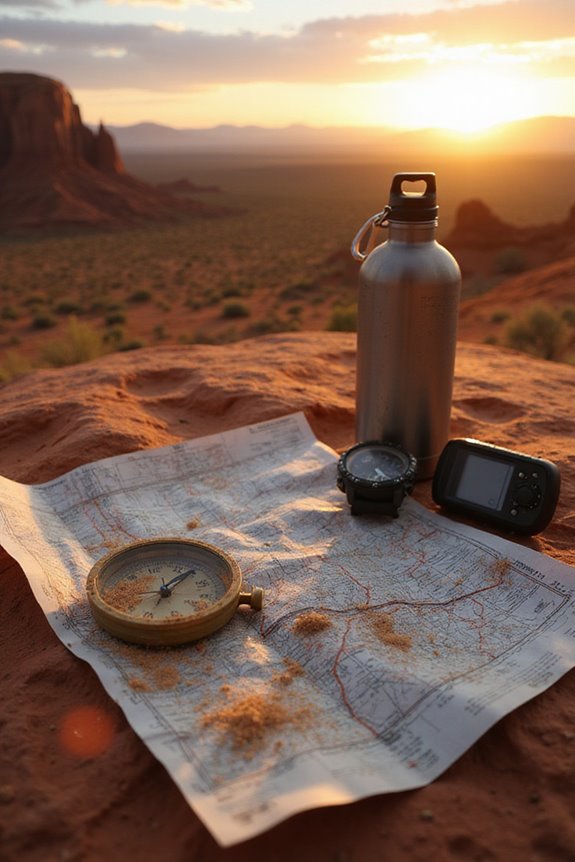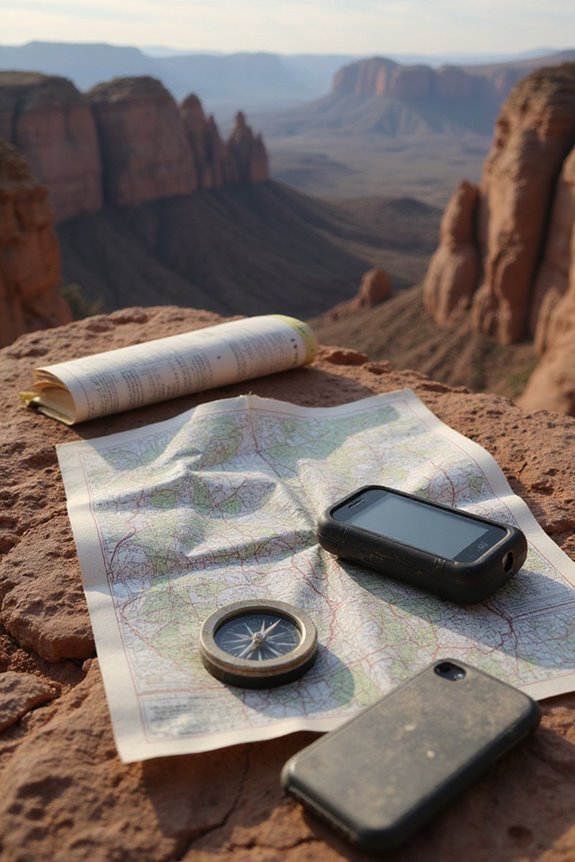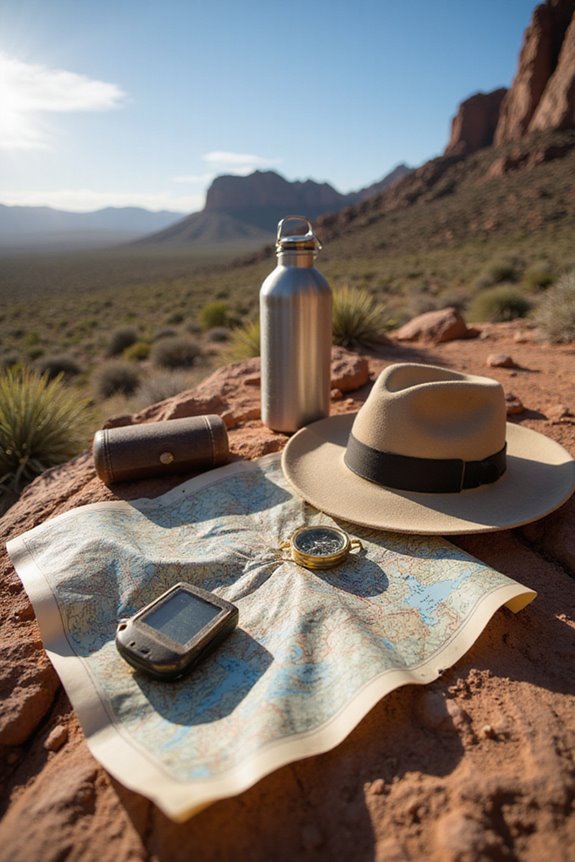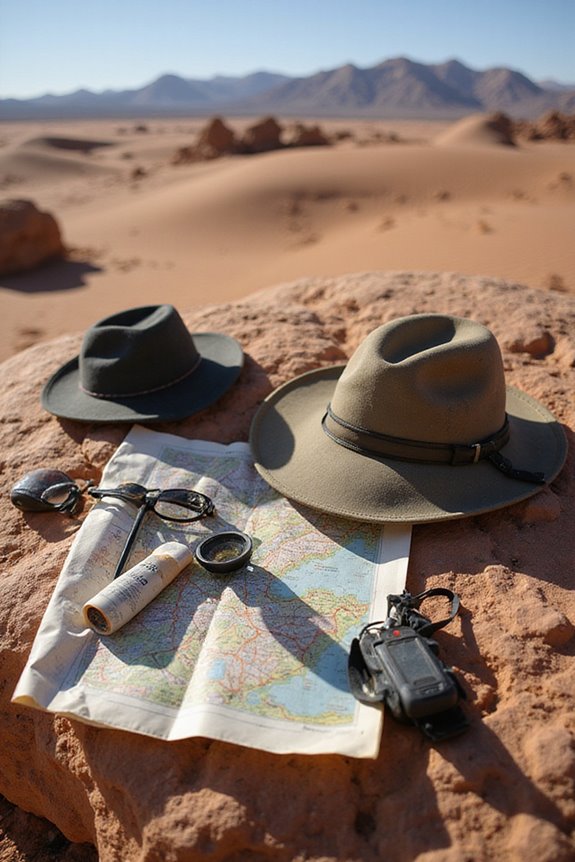When choosing desert navigation methods, let’s gear up with a reliable compass and topographic maps for the best guidance! I love using natural landmarks, too—they’re like nature’s GPS. Don’t forget to master dead reckoning techniques; they keep us from getting lost like a tumbleweed in the wind. And remember, hydration is key! Stay adaptable and mix modern tech with old-school methods. Stick with us, and we’ll make sure you’re prepped for every adventure ahead!
Key Takeaways
- Choose a reliable compass and consider carrying a backup for redundancy in navigation.
- Use topographic maps to understand terrain features and plan your route effectively.
- Incorporate natural landmarks and triangulation for accurate positional awareness during navigation.
- Master dead reckoning techniques and regularly update your position for consistent tracking.
- Prioritize safety by planning for hydration, sharing your travel details, and staying adaptable to changing conditions.
Understanding Essential Navigation Tools
When we venture into the vast stretches of the desert, knowing our navigation tools is just as essential as picking the right trail—or at least avoiding the wrong one! A reliable compass is key. We trust magnetic compasses to align with Earth’s magnetic field, giving us our cardinal directions. But hey, let’s not put all our eggs in one basket—carrying two compass types adds those crucial navigation redundancies. And don’t forget those topographic maps! They’re invaluable for route planning and spotting potential dangers or water sources. Plus, if our gadgets decide to play hide and seek, we’ve got our classic tools to guide us. Consider investing in a hiking GPS device with sunlight-readable displays for maximum visibility in the intense desert sun. So, let’s gear up, and embrace the wild freedom of the desert!
Utilizing Natural Landmarks for Orientation
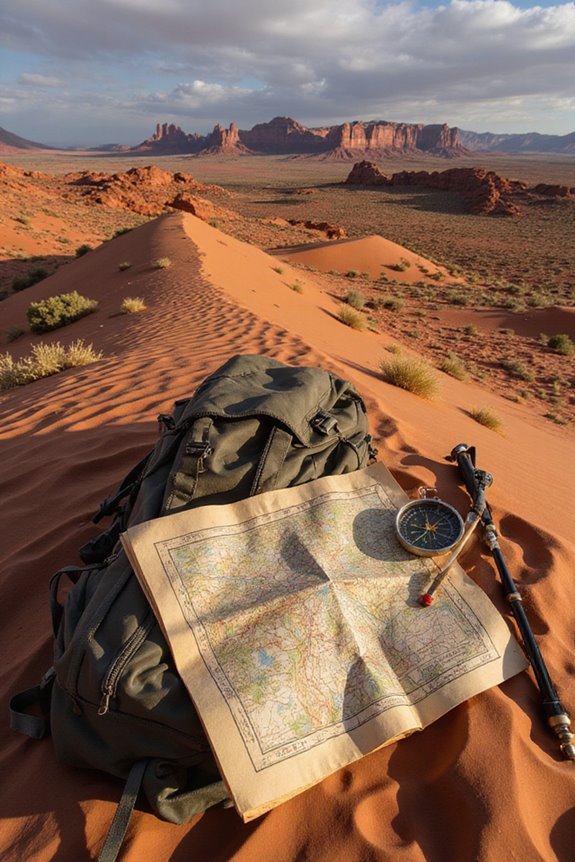
As we traverse the arid expanses of the desert, we can’t afford to overlook the incredible value of natural landmarks for orientation. Distinctive rock formations? They’re our friends in the featureless landscape! Mountain ranges stand steadfast, guiding us through shifting sands. Isolated patches of vegetation can also offer vital visual cues. Plus, who doesn’t love spotting an old dry riverbed that whispers tales of past journeys?
When we triangulate between three or more landmarks, we enhance our position accuracy. It’s like a secret code only we comprehend! As we memorize these features, confidence surges. Remember, the desert changes—keep an eye out for shifting dunes, but don’t stress; we’ve got this! Let’s embrace the adventure with our trusty natural guides! Having the Ultimate Tiny Survival Guide in your pack provides essential knowledge for navigating unexpected situations when landmarks become obscured by changing weather conditions.
Mastering Dead Reckoning Techniques
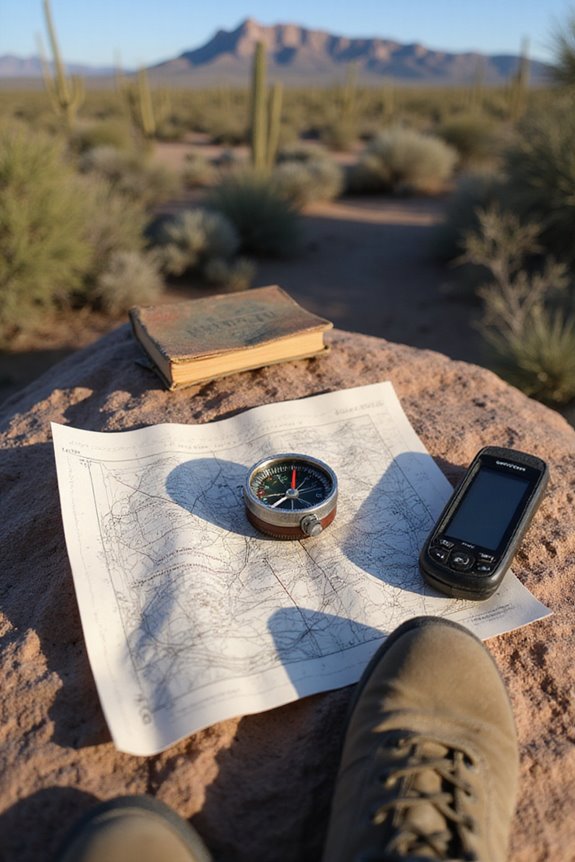
Traversing through the vast desert can feel like stepping into a scene from a sci-fi movie—endless sandy waves stretching to the horizon with barely a landmark in sight! That’s where mastering dead reckoning techniques becomes our secret weapon. We start from a known position, using pace counting to track our steps. It’s like counting sheep but way more thrilling! As we move, we align our compass bearing—remember, “red in the shed” keeps us on course. Every 30 minutes, we update our position to fend off any mistakes that creep in. With practice under the sun’s glare or the starry sky, we’ll navigate this canvas of sand like pros. For emergencies in these remote areas, carrying a personal locator beacon can provide crucial GPS tracking capabilities that may save your life when traditional navigation fails. So let’s embrace this freedom together and find our way!
Interpreting Maps and Analyzing Terrain
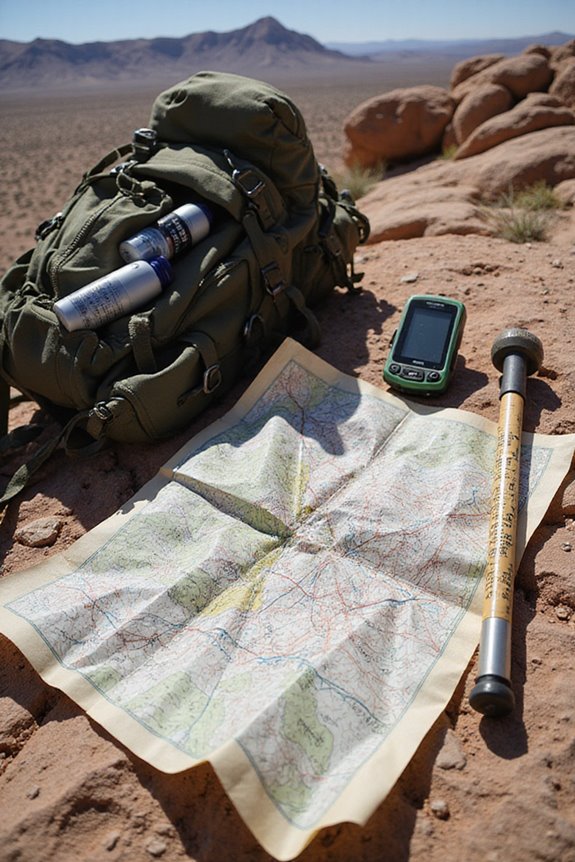
Understanding maps is like revealing a treasure chest filled with navigation gold! We’re starting our desert adventure, but first, we need to decode those intricate map symbols. Elevation changes illustrated through contour lines can be our friends; closely spaced lines scream “steep!” while widely spaced ones say, “easy-peasy.” With scale, we can pinpoint our route like pros!
Now, let’s chat about terrain textures. Is it sandy or rocky? This detail can mean the difference between a sprinter’s pace and a slow crawl! Visibility and orientation are our best allies—aligning our map with compass north is essential. When navigating challenging desert terrain, having a compact multitool can help you overcome obstacles and adjust equipment on the go. So, let’s immerse ourselves in this topographical wonder, turning these maps into our navigational compass to freedom! Onward!
Navigating in Low Visibility Conditions
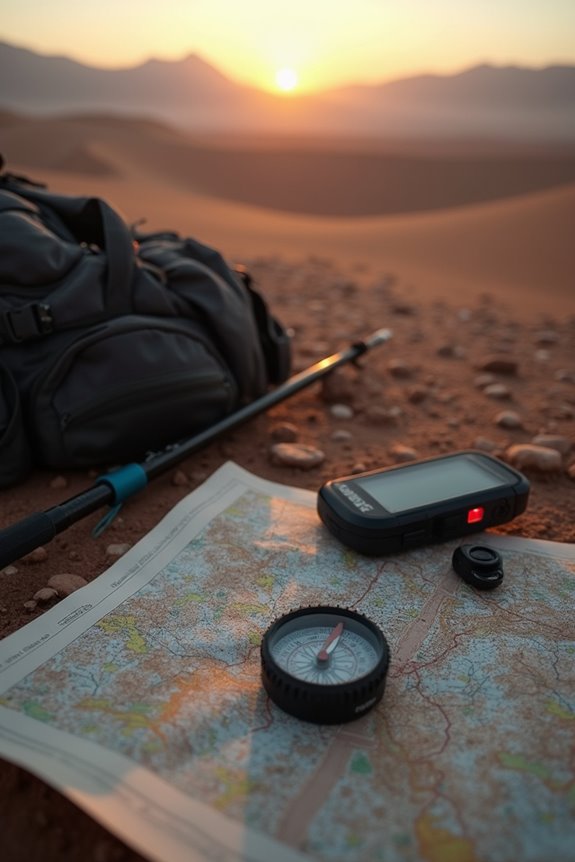
When the sandy winds whip up and visibility drops faster than a mirage vanishing in the heat, our adventure doesn’t have to end! We’ll rely on dead reckoning, using our compass and topographic map to stay on track. By setting and adjusting bearings every 10 to 15 minutes, we’ll keep errors at bay.
We can also leapfrog ahead, sending one of us forward, like a fearless scout, while the rest follow, sticking to our communication signals. Sound carries in the open desert, so a tap on the shoulder or a whistle works wonders! Let’s make sure we’re well-prepared, with backup tools at hand. Consider bringing collapsible trekking poles that can compact to 14 inches for easy storage while providing stability on uneven desert terrain. Embrace the challenge, and let’s navigate together—and maybe laugh a little at the chaos!
Preparing for Desert Navigation Challenges
Desert wayfinding isn’t just about finding your way; it’s a dance with the elements under the blazing sun! We all crave that freedom of exploring wide-open spaces, but we must gear up for those desert survival challenges. Think rugged backpacks and lightweight tents—trust us, your back will thank you! And don’t forget your high-SPF sunscreen; even the toughest among us aren’t immune to a sunburn.
Stay hydrated! We should carry enough water tailored to the heat. Master techniques for purifying water, ‘cause you never know when a mirage might trick us. Plus, when planning our routes, we’ve gotta think strategically. Guiding ourselves towards lines and landmarks keeps us oriented. Let’s embrace the wild, but let’s make sure we’re prepared for the unexpected so we can truly enjoy the journey!
Safety Considerations for Desert Travel
While we may dream of endless sun-soaked adventures, safety’s our best friend in the desert. First things first, hydration is key—let’s plan on at least a gallon of water each per day, and more if we’re really getting our sweat on! We’ve got to be smart about our hydration strategies. Also, let’s keep an eye out for the local wildlife; those snakes and scorpions aren’t here for tea! Always shake out our boots before getting comfy.
And speaking of comfy, we should share our travel details with a trusted friend—let them know our route and check in when we’re back. The desert is a wild beauty, but with these little safety tips, we’ll conquer it like pros!
Combining Modern and Traditional Navigation Methods
As we gear up for our desert adventures, it’s exciting to think about how we can blend modern tools with ancient wisdom to navigate this stunning landscape. By embracing the cultural context of traditional navigation, we can honor the age-old techniques of reading environmental cues like wind patterns and celestial bodies. Let’s integrate our navigational intuition with GPS and compasses, allowing tech to support our instincts rather than replace them.
Imagine tracking our position using both a smartphone and the stars! It’s all about redundancy. If GPS glitches or sandstorms blur our view, those mental maps and compass bearings can save the day. We get to weave together the old and the new—now, that’s the freedom of exploration in the desert!
Practical Tips for Effective Desert Navigation
When we hit the sandy trails, knowing the ins and outs of desert navigation can make all the difference in turning an ordinary hike into an epic adventure. First, let’s master compass calibration! Before we set out, check that compass. It can save us from windy confusion. While we’re at it, let’s embrace terrain awareness. Those monotonous dunes? They’ve got secrets. Knowing the elevation and landmarks on our topo maps makes all the difference when we’re chasing the horizon. Don’t forget to watch for the signs nature gives—bird flocks can lead us to water! And if all else fails, a trusty GPS can be our backup buddy. Just remember, it’s about experiencing freedom on the open desert, not just finding a path!
Frequently Asked Questions
What Are Common Myths About Desert Navigation?
When it comes to desert navigation misconceptions, we’ve got to debunk those myths! Relying on old beliefs can lead us astray. Let’s explore these truths together, embracing the freedom of accurate knowledge for our adventures.
How Can Technology Failures Impact Navigation in Deserts?
We’ve seen how GPS limitations and signal interference can dramatically hinder our navigation in deserts. These technology failures can lead us astray, compromising our freedom and safety amid the vast, unforgiving terrain we seek to conquer.
What Psychological Factors Affect Navigation Accuracy in Desert Environments?
We recognize that cognitive biases and environmental stressors greatly impact our navigation accuracy in deserts. As we face harsh conditions, it’s essential to remain aware of our mental state and adapt accordingly for better decision-making.
How Much Water Should I Carry While Navigating the Desert?
When we trekked through Death Valley, we carried 3 liters each to stay hydrated, knowing water consumption rises quickly. Utilizing smart hydration strategies guarantees we embrace freedom on our adventures without anxiety about thirst or dehydration.
What Wildlife Poses Navigation Challenges in Desert Areas?
When we think about wildlife affecting navigation in deserts, we notice how their behavior and navigation strategies complicate our own routes. Understanding this interaction helps us navigate more freely while respecting the unique challenges they face.

